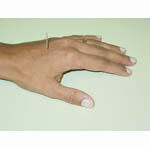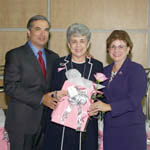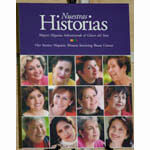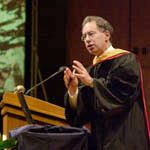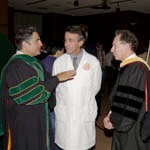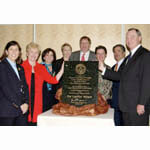San Antonio (Oct. 19, 2004) – The Regional Academic Health Center (RAHC) Medical Library, a branch of the Dolph Briscoe Jr. Library at The University of Texas Health Science Center at San Antonio, has been selected to receive the nation’s highest honor for public service provided by museums and libraries. The award, presented by the Institute of Museum and Library Services, includes $10,000 and recognition at a national award ceremony in Washington, D.C.
“I welcome the news of this prestigious award for our talented and capable team of library professionals,” said Francisco G. Cigarroa, M.D., president of the Health Science Center. “The extension of state-of-the-art library services to health professionals, students and lay health promotion workers in the Lower Rio Grande Valley, where the RAHC Medical Library is located, is a testament to individual ingenuity and the support of many partners, including the state legislators who saw library services as a crucial area of need.”
Located in Harlingen, the RAHC Medical Library is the first health sciences library – indeed the first library at an institution of higher education – to win the National Award for Museum and Library Service. Mary J. Moore, Ph.D., director of libraries at the Health Science Center, said the honor actually caps decades of visionary work by the library staff in San Antonio to reach out to Valley health professionals and their patients.
The rapidly growing population of the Valley is more than 80 percent Hispanic. One-third of the area’s 1 million residents live below the poverty level. Many residents experience transportation, language and cultural barriers that substantially limit access to health care.
“The establishment of the RAHC Medical Library in 2001 provided the first medical library in the Lower Rio Grande Valley,” Dr. Moore said. “Open to the public, this library serves not only the faculty, staff and students of the Regional Academic Health Center, but records more than 2,000 visits a month from students and faculty of health programs at other regional institutions.”
The Health Science Center is authorized by the Texas Legislature to operate the Medical Education and Medical Research Divisions of the RAHC. Each year, 24 third-year and 24 fourth-year medical students from the Health Science Center are educated and trained at the RAHC Medical Education Division in Harlingen and at the RAHC’s many clinical partners, which include the Valley Baptist Health System and Su Clinica Familiar. The RAHC Medical Education Division also provides medical residency programs.
Debra Warner, director of the RAHC Medical Library, will travel to Washington with Dr. Moore on a date to be determined for the national award ceremony. Warner completed a needs assessment of the Lower Rio Grande Valley in 2001, meeting with public librarians, agency directors and outreach workers throughout the area. “Partnerships have been established with high schools and health action groups, and we have provided training in the use of quality health information for parish nurses, school nurses and ‘promotoras’ (lay outreach workers),” Warner said.
Last year, more than 2,000 students and teachers from the Valley were trained in the use of quality health information on the National Library of Medicine’s MEDLINEplus, Warner said. Many of the young people were from the South Texas High School for the Health Professions, a regional magnet school known as “Med High.” Others were from high school chapters of the Health Occupations Students of America. “A survey at Med High showed that, on average, each Med High student has demonstrated the Internet-based health information sources to three other people in the community,” Warner said.
The RAHC Medical Library also is training Health Science Center medical students and internal medicine residents about the problems of health literacy among patients and about the use of consumer health resources in Spanish and English to accommodate largely Hispanic patient populations.
The Briscoe Library’s founding director, David Kronick, Ph.D., had the original vision in 1965 to hire an outreach librarian to serve South Texas. That was just six years after the 1959 legislative charter that gave the Health Science Center the responsibility to serve all of South Texas, including Cameron, Hidalgo, Willacy and Starr counties, the four counties that make up the Lower Rio Grande Valley. Dr. Kronick’s idea later took shape as a “circuit librarian” program throughout South Texas. “Mary Jo Dwyer and Graciela Reyna were our pioneering circuit librarians,” Dr. Moore said.
The Briscoe Library’s second director, Virginia Bowden, Ph.D., successfully obtained funding from the National Library of Medicine (NLM) for the RAHC Medical Library’s programs. She made a personal visit to the NLM in Washington and wrote the original creative proposals with Debra Warner. “Today, 33 staff members of the Briscoe Library work on a day-to-day basis to support the RAHC Medical Library,” Dr. Moore said. When Dr. Bowden retired in 2003, the Health Science Center conducted a national search and recruited Dr. Moore from her position as head of reference and customer services at the NLM.
The RAHC Medical Library also would not be a reality without the leadership of the Valley legislative delegation, especially that of state Sen. Eddie Lucio Jr., author of the bill that established the RAHC, and state Sen. Juan “Chuy” Hinojosa, at the time a state representative, who sponsored the bill in the House. “This award acknowledges that outreach is a longstanding mission or heritage of the Health Science Center libraries,” Dr. Moore said. “We also acknowledge our dedicated legislators and community partners who have helped make the RAHC Medical Library and its programs a success.”
This fall, the RAHC Medical Library and the Biblioteca Las Américas Library, located at Med High, received the Blue Ribbon Consumer Health Information Award from the National Commission on Libraries and Information Science for the MEDLINEplus peer tutor project.


